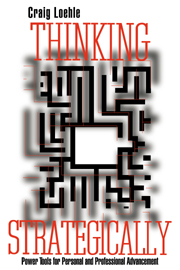Book contents
- Frontmatter
- Contents
- Acknowledgements
- Introduction
- PART 1 Component skills of strategic thinking
- 1 Strategic creativity
- 2 Discovery as a process
- 3 Strategic problem solving
- 4 Reality check
- 5 A matter of style
- 6 Attitude: The inner strategist
- 7 Strategic thinking exercises
- PART 2 Strategic thinking in practice
- Summary: The strategic thinker
- Literature cited
- Index
6 - Attitude: The inner strategist
Published online by Cambridge University Press: 24 September 2009
- Frontmatter
- Contents
- Acknowledgements
- Introduction
- PART 1 Component skills of strategic thinking
- 1 Strategic creativity
- 2 Discovery as a process
- 3 Strategic problem solving
- 4 Reality check
- 5 A matter of style
- 6 Attitude: The inner strategist
- 7 Strategic thinking exercises
- PART 2 Strategic thinking in practice
- Summary: The strategic thinker
- Literature cited
- Index
Summary
The purpose of this chapter is to explore the role of attitude in enhancing strategic problem solving and innovation. Attitude is well known to be important in sports, sales, and the arts, but is not as appreciated in the context of problem solving. However, because our thinking processes are nearly as subject to derailment, delusion, and mistake as are our aesthetic and athletic performances, the role of attitude (the inner strategist) is even more important. As a model for assessing the role of attitude in problem solving, I take not the arts, but science. The arts are primarily a vehicle for emotional and intellectual expression rather than practical problem solving. Furthermore, in the arts no objective criteria exist for judging success or truth. Therefore, if an artist attributes his or her creativity to having taken drugs, it is very difficult to evaluate this claim. I have focused on science because the creative act in science must result in a practical, workable solution to some problem. There is an objective criterion for judging success in science by which we can evaluate whether some attitude or behavior helps or hinders creativity. It would also be possible to use engineering as a model here, but there are too few accounts on which to base an analysis.
The creative act
Not everything done in science may be considered creative. A major part of the edifice of science consists of a toolbox of techniques and instrumentation.
- Type
- Chapter
- Information
- Thinking StrategicallyPower Tools for Personal and Professional Advancement, pp. 94 - 101Publisher: Cambridge University PressPrint publication year: 1996



